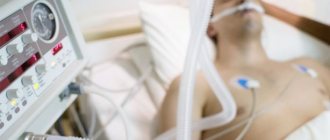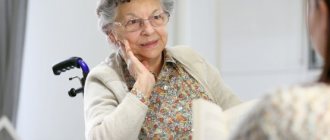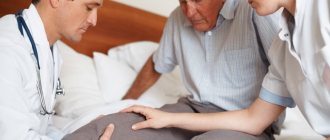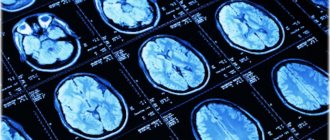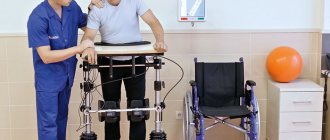- home
- Diseases
After the third stroke, the patient’s prognosis and chances of survival, and then rehabilitation, deteriorate sharply. The problems that arise in a patient who has suffered a third stroke greatly complicate his communication with other people. In some patients, intellectual skills suffer and difficulties arise in self-care. A third brain injury, an ischemic or hemorrhagic stroke, can be fatal. If a person survives an apoplexy, treatment should be carried out followed by a long period of rehabilitation.
Symptoms of an impending stroke
A person should take timely action if he has already had 2 strokes and noticed the following signs:
- Performance deteriorated sharply, and sleep partially disappeared.
- Partial amnesia may appear as the main symptom of the disease: a person does not remember events that happened to him several hours ago.
- Headache caused by changes in weather or overwork.
- Noises in the ears. They can occur in the form of intermittent noise or occur in the background during any activity of the patient.
- Feeling dizzy when moving or at rest.
If there is no doctor nearby, then to identify the disease to people near the sick person, you can use 4 signs of a stroke (they manifest themselves in acute circulatory disorders in the brain):
- When a person loses consciousness and falls, and then is brought back to his senses, you need to ask him to smile. When a patient has a stroke, their smile looks unnatural, because... Any corner of the mouth does not rise.
- You can ask such a patient to raise both hands. If he is ill, he will be able to raise only one of his arms or the movement of both limbs will be incomplete.
- The speech of a patient with a stroke will be slurred: he will not be able to pronounce a whole sentence.
- If a patient is ordered to stick out his tongue, he will be able to fulfill the request only by twisting one of the sides of the oral cavity.
Forecast
In a situation where a third stroke occurs, the prognosis for each patient will be individual. It depends on a combination of factors. People who have had apoplexy three times have a risk of death, which is especially high in the first 2-5 days after the attack. If death does not occur, the person will face long-term treatment and subsequent rehabilitation. Often people lose skills without which they cannot take care of themselves.
What does the forecast depend on?
When doctors assess the chances of recovery and predict the condition of patients who have suffered a third stroke, they start from the following data:
- patient's age;
- type of cerebrovascular accident;
- severity of the violation;
- location of the brain lesion;
- biochemical blood parameters;
- blood pressure indicators;
- patient's body temperature.
Based on this information, the doctor can understand what complications the patient will encounter and whether rehabilitation measures will help restore lost functions.
Early forecast
Early prediction helps the doctor prescribe the most appropriate treatment for the patient. The prognosis is more favorable for patients at a young age. The absence of other diseases increases the chances of recovery. In the case of mild neurological symptoms, there is a greater chance of rehabilitation of the patient.
Important information: What are the consequences of a cerebral stroke in men (women) and how long can a person live after suffering an attack on his feet?
If a person lives alone and has mental health problems (such as depression), the chances of regaining function are reduced. When providing medical care to a patient who has suffered a third stroke within 2-5 hours, the prognosis is more favorable.
Late forecast
A month later, the doctor makes a new prognosis based on the patient’s condition. It assesses the degree of impairment of speech and vision functions. An important factor is what mood the patient is in.
If improvements in the patient's skills are observed, the likelihood of further recovery is greater. With paralysis and impaired consciousness, the prognosis is unfavorable.
What determines the prognosis after three strokes?
Doctors have identified factors influencing a patient’s survival after a third stroke:
- Constantly present, practically unchangeable indicators: the severity of the patient’s symptoms of the disease, the type of disease, the location of the stroke, the age of the patient.
- Variables: biochemical parameters of blood plasma, blood pressure, presence of temperature in the patient.
By monitoring the second group of indicators, doctors are in some cases able to cure a patient who has suffered 3 strokes. But this happens quite rarely.
With the third stroke, the consequences most often lead to the death of the patient within 2-5 days. If the person survives, complications are possible:
- Brain swelling.
- Memory loss.
- Development of seizures.
- Paralysis.
- Severe headache, cerebral hemorrhage.
- Impaired coordination of movements.
- Aphasia (loss of speech and writing skills).
In addition to these phenomena, peripheral neuropathy, the development of psychosis and coma may be observed. Each of these complications has its own symptoms, which doctors must take into account. For example, cerebral edema is characterized by headache, neck numbness, dizziness, blurred vision and other symptoms.
Cramps can occur in any muscle group with extensive bleeding in the brain.
Most often, after the third apoplexy, the patient develops paralysis of the limbs, which passes without atrophy of the muscle structures.
Aphasia is a consequence of damage to the left half of the brain. During recovery, a person will need the help of a speech therapist, because... he loses his speech skills and cannot listen normally. To restore all speech and writing skills, the patient must begin treatment within the first 2 weeks after the stroke.
Ischemic stroke
Treatment of the consequences of ischemic stroke can be divided into several areas:
- Restoration of movement (sessions with a physical therapist, aquatherapy, exercises on simulators, use of modern techniques: Bobath therapy, Exarta, PNF method);
- Returning independence in everyday life (sessions with an ergotherapist in a specially equipped training apartment);
- Restoration of speech and swallowing;
- Drawing up a menu with the recommendations of the attending physician;
- Blood pressure control and drug therapy;
- Hygiene procedures (including ostomy care and ostomy removal);
- Symptomatic treatment (prevention or treatment of bedsores, pain relief, etc.);
- Restoring control of the pelvic organs;
- Treatment of depression, help from a psychologist.
The rehabilitation program is carried out in three stages.
The first stage begins in the first days after an ischemic stroke. The possibilities for active rehabilitation are limited, since the patient is in bed and inactive. The patient is turned over, massaged, and breathing exercises are performed.
It is important to communicate with the patient, even if his own speech is impaired or he cannot respond. Speech perception affects the functioning of functional areas of the brain and has a positive effect on the emotional and physiological state of a person.
The second stage lasts up to several months after the stroke. It can take place either directly in a hospital or in a specialized rehabilitation center. During this period, massage, therapeutic exercises, and physiotherapy are prescribed. Specialists work on speech and cognitive functions (memory, thinking, imagination). This stage can last up to six months: it all depends on the severity of the stroke.
In the late, third, rehabilitation period, active methods are used to restore functions and skills. Fine motor skills and self-care skills are restored. It is also important to develop the patient’s commitment to rehabilitation measures and a positive attitude.
In some cases, one or two courses of rehabilitation are sufficient (the patient is discharged with detailed recommendations and a set of exercises to be performed at home).
deals with treatment after ischemic cerebral stroke. Each specialist conducts an individual examination of the patient and sets time-bound and achievable goals. Team members interact and exchange information to ensure that rehabilitation is effective.
Early and late diagnosis of the disease
The early detection of circulatory disorders in the brain structures has a great influence on the final result of rehabilitation. If this is successful, the doctor first assesses the patient’s condition using the following indicators:
- The number of points is determined using a special stroke scale.
- The time from the onset of the disease is recorded.
The patient is examined using MRI, determining the volume of tissue affected by the disease. After this, the patient is diagnosed and the prognosis for rehabilitation is considered. In fact, this is an attempt to predict what may happen to a patient in the first month after a stroke.
The sum of points on the disease scale allows doctors to predict what will happen to the patient after another stroke. The patient's chances of recovery increase sharply if he is under 40 years old and has a spouse. A low (compared to other patients) body temperature during the acute stage of the disease can give a chance for successful rehabilitation.
Rehabilitation conditions improve if, in the first 7 days after a stroke, a person experiences positive dynamics, indicating some improvement in the patient’s condition. Such patients quickly restore speech skills and motor functions.
When diagnosing a stroke in a person late (it is carried out 30 days after the onset of the disease), doctors assess the condition and the chances of recovery based on factors such as:
- Manifestations of impaired motor function, speech disorder (at the same time, vision damage is possible), a drop in the patient’s mood, a change in his behavior.
- A person who has suffered a stroke experiences difficulties with self-care and movement, and cannot go to the store or drive a car on his own.
- After the third apoplexy, most patients cannot work in the same place.
After taking into account all these factors, doctors make a prognosis for the recovery of a particular patient after a stroke. If treatment is possible, the patient is prescribed the appropriate drug. Full recovery occurs in only 12-15% of the total number of patients with stroke.
An unfavorable outcome occurs when the patient has impaired perception and consciousness, persistent paralysis of the limbs, and signs of urinary incontinence.
Consequences
With the third stroke, the consequences are more complex than with previous attacks of acute cerebrovascular accident. After the first stroke, there is a high chance that a person will regain lost functions; after the second violation remains, but you can adapt to everyday life; complications of a third stroke often lead to a significant decrease in a person’s quality of life.
In most cases, this situation results in disability. There is a high risk of death, especially with hemorrhagic stroke. The older the patient, the higher the risk that the disorder will lead to death.
Consequences that often occur when a patient has suffered a third stroke:
- Disturbances in the motor system. There is a possibility of complete paralysis. In this state, a person is not able to independently satisfy the simplest needs. Sometimes there is a need for artificial nutrition.
- Speech disturbances occur - a person may speak slurredly or fail to pronounce some sounds. It may be difficult to formulate proposals. If intellectual functions are impaired, speech may become meaningless. With speech problems, death often occurs due to the fact that the patient could not call others for help.
- Mental abilities often decrease and mental disturbances appear. Personality disorders may occur. When parts of the brain responsible for memory are damaged, some memories are lost.
- A common complication is coma, in which case hospitalization is required.
Important information: Consequences of cerebellar stroke and life expectancy prognosis
Patients may not have problems with consciousness, but impairments in speaking and motor functions make it difficult or impossible to communicate with others.
The symptoms that occur after a third stroke make it impossible to live independently in most cases. To maintain vital functions, the patient needs medical care, the care of a nurse, or the supervision of relatives.
Due to the severity of the consequences that result from repeated cerebrovascular accidents, it is extremely important to call an ambulance at the first signs of a stroke.
Rehabilitation after illness
After a mini-stroke, recovery may take 2-3 months, but after extensive brain damage, rehabilitation will be lifelong. It can be done at home or in a medical facility, with the involvement of specialists or loved ones.
The initial stage requires the use of drugs:
- thrombolytics to dissolve blood clots;
- drugs to improve microcirculation and tissue trophism;
- sedatives to relieve anxiety;
- muscle relaxants to eliminate muscle spasms;
- antihypoxants against oxygen starvation;
- medications to lower blood pressure.
In the future, massage specialists and speech therapists are involved in rehabilitation; physical therapy is required - electrical stimulation of muscles, ozokerite, paraffin, magnetic therapy, acupuncture.
